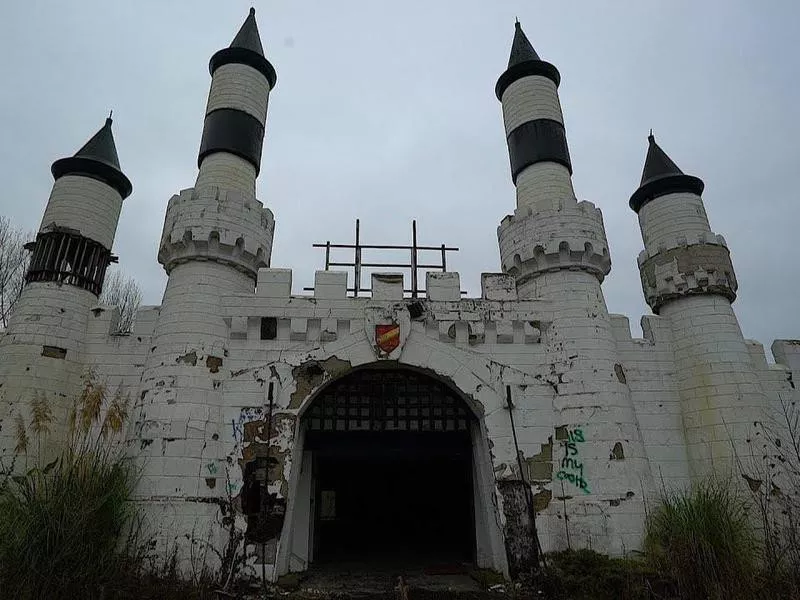Creating a fantastic travel attraction is no easy feat. Sometimes an attraction is simply an absurd or horrifying idea. Other times, screw-ups happen in the execution, causing well-intentioned efforts to go completely off the rails. And then there's the effect of sheer bad luck, with market forces beyond anyone's control wreaking havoc.
In any case, when a tourist attraction goes south, it can cost people their jobs, send folks to jail, damage the environment — or even lead to death.
We found 15 instances in which a particular attraction or campaign either never came to fruition or was doomed from the start.
Shania Twain Centre
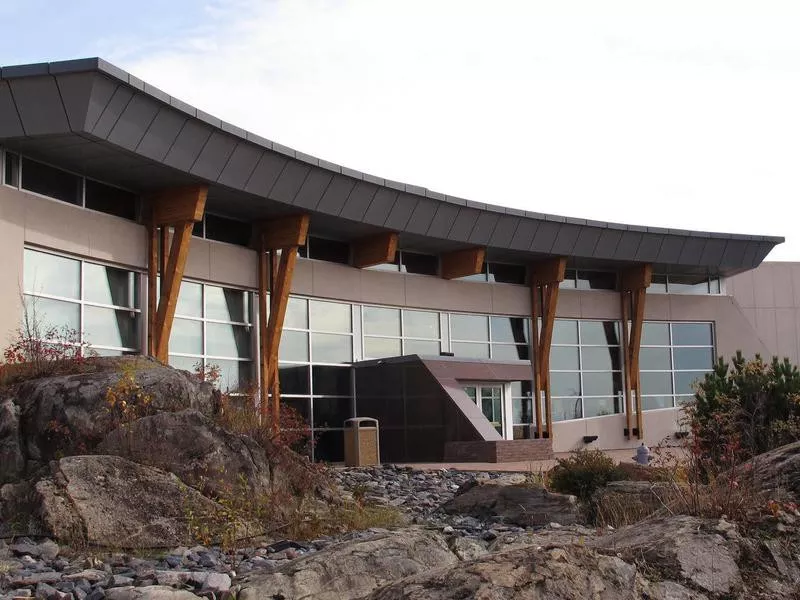
Takashi Toyooka / flickr
Where: Timmins, Ontario, Canada
Opened in: 2001
Closed in: 2013
Few Canadians are as famous as Shania Twain, the all-time best-selling female country artist, so it’s only natural that she would have a special attraction in the town where her music career began. But, well, the Shania Twain Centre just never found its voice.
For one thing, it was a seven-to-eight-hour drive north from Toronto — a postcard for “the middle of nowhere.” For another, it was a little bizarre — in addition to showcasing Twain memorabilia, it randomly partnered with a historic gold-mining tour, despite that having nothing whatsoever to do with the singer’s career.
Perhaps that’s why, despite much fanfare and a concerted marketing effort, only 12,500 people officially visited the center the first year it opened (it took Twain herself three years from the opening to pay a visit — not a good sign). Several thousand more fans came the next year, but then the numbers started to tumble.
The center failed so thoroughly to impress people much that it closed in 2013, then was demolished.
South China Mall

David290 / Wikimedia Commons
Where: Dongguan, China
Opened in: 2005
Closed in: Still open
When it debuted, South China Mall had ambition to spare. The largest mall in the world opened at twice the size of the famously epic Mall of America in Minnesota, offering more than 7 million square feet of retail space, a rollercoaster and — for good measure — replicas of the Venetian gondolas and Paris’ Arc de Triomphe.
But defying the mantra “if you build it, they will come,” the mall fell far short of expectations, never coming close to reaching its goal of 200,000 visitors a day, and eventually seeing 99 percent of its mall space left vacant.
Last year, there were reports that renovations were turning the tide on the mall's fortunes. But still it remains mostly known by its unfortunate nickname: “Ghost Mall.”
Revel Casino
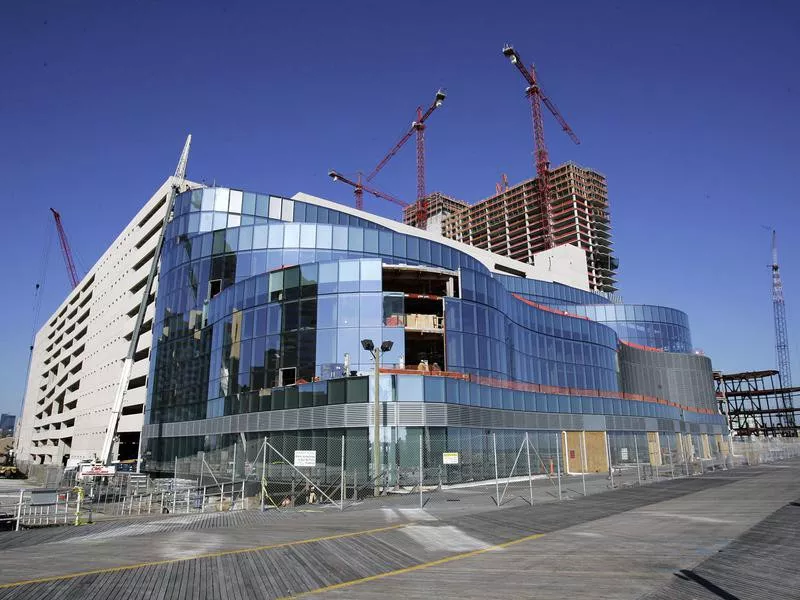
Construction of Revel Casino as seen in January 2009 Mel Evans / AP Photo
Where: Atlantic City, New Jersey
Opened in: 2012
Closed in: 2014
Atlantic City’s financial woes are no secret. The once-happening gaming hot spot suffered mightily during the great recession, and no resort failed more spectacularly than Revel.
For one thing, the casino came with an exorbitant price tag: $2.4 billion. It was also massive, comprising a pair of 700-foot towers, 4,000 rooms and 7,000 parking spaces. And it debuted to massive fanfare, nabbing Beyonce as its opening-day performer.
But despite all that, it couldn’t lure visitors, causing it to close down a mere two years after opening.
A few years later, it would seem the building is still cursed. Now operating as Ocean Resort Casino, the property has been sold a couple times since its days as Revel, and has been mired in continual financial struggles.
Harmon Hotel
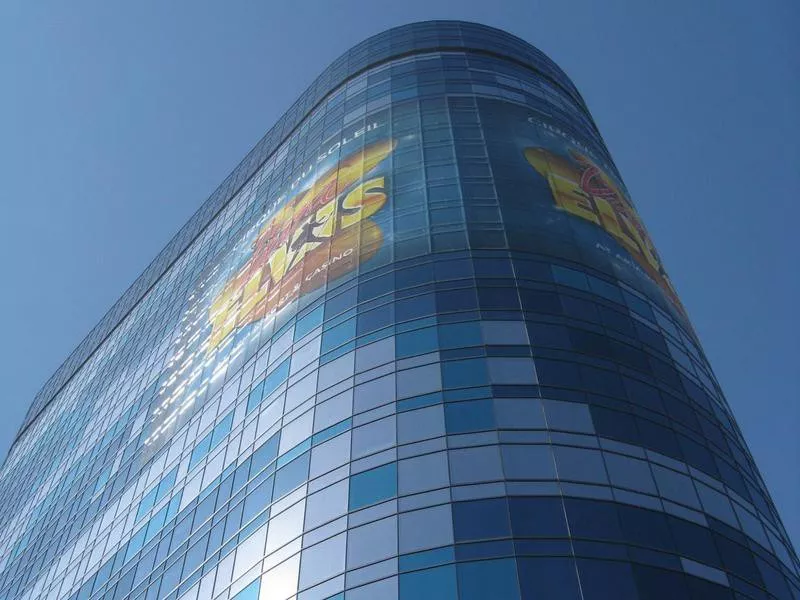
Frisocali / flickr
Where: Las Vegas, Nevada
Opened in: 2009
Closed in: 2015
Like Atlantic City, Las Vegas is a gaming mecca that’s faced its share of economic woes. And its biggest Revel-like catastrophe was the Harmon Hotel.
The property was designed to span 49 floors and encompass 400 rooms and 200 condos in the heart of the city’s splashy new CityCenter. Its price tag? A cool $275 million.
But mid-way through its completion, with 26 stories done, an engineer discovered significant construction issues, and the project was halted. Unable to fix the situation, developers eventually had the building demolished, leading to a legal mess and a legacy as one of the most expensive tourism flops in history.
Wonderland Amusement Park
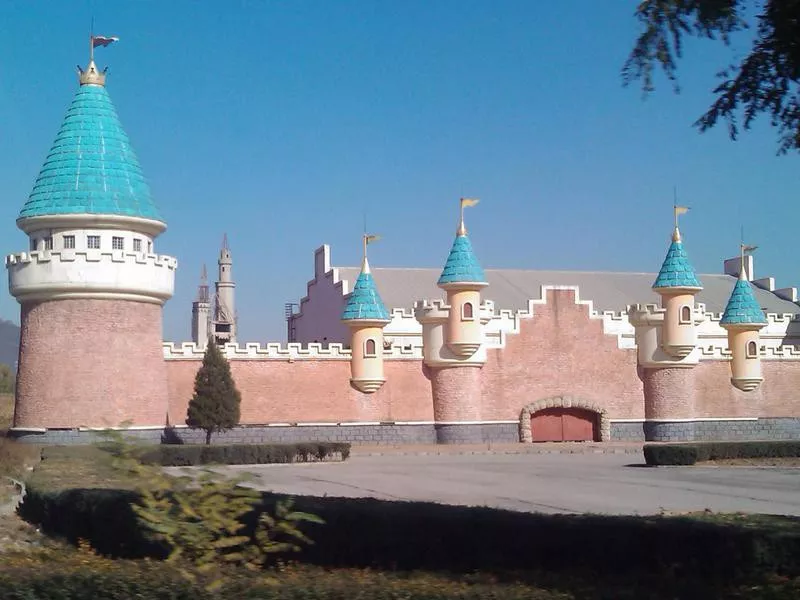
Bertrouf / Wikimedia Commons
Where: Beijing, China
Opened in: Never opened
A compilation of tourism failures easily could’ve focused solely on Disney projects, but that wouldn’t have been much fun. Wonderland Amusement Park in Beijing, however, is the granddaddy of botched Disney ideas.
The project started in the mid-1990s and, at 120 acres, would’ve been the largest amusement park in Asia. But it was abandoned by 1998 due to disputes between landowners and developers and a political scandal involving a Communist Party leader from Beijing.
For years, the site sat stagnant, with a ghostly-looking castle holding court over its abandoned remnants. It was almost resurrected to coincide with the Beijing Olympics in 2008, but that never came to pass.
Five years later, demo crews finally put the rotting, half-built structures out of their misery.
Heritage USA
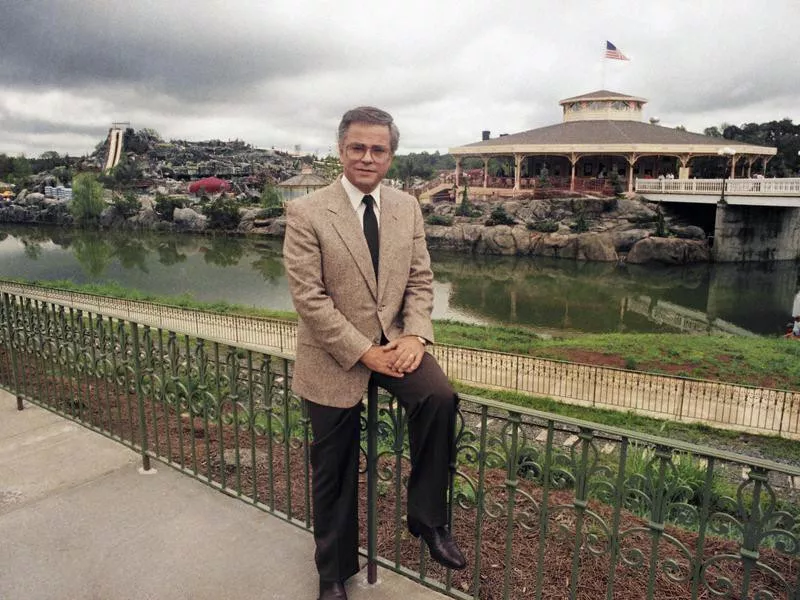
Jim Bakker poses in front of the Heritage USA Water Park in March 1987. Lou Krasky / AP Photo
Where: Fort Mill, South Carolina
Opened in: 1978
Closed in: 1989
A small town in South Carolina is home to the eerie remnants of what was, in the mid-1980s, the third-most-popular theme park in the U.S. But unlike Disney World and Disneyland — the two most popular parks — Heritage USA was a Christian-themed attraction operated by Jim and Tammy Faye Bakker's PTL Ministry.
For a time, the park was wildly popular, drawing millions of visitors a year to its attractions, including a skating rink, a castle, an evangelism school, a theater for religious-themed shows, a chapel and a Disney-esque Main Street.
However, everything came crashing down due to scandals that were anything but pious. Jim Bakker was a swindler and sexual abuser who improperly used church funds and allegedly drugged and raped church secretary Jessica Hahn before trying to pay her off to keep quiet. He would end up going to jail not for the rape, but for the misuse of church funds.
Jerry Falwell took over the theme park, but it would never recover. And in perhaps a fitting end, it was officially closed after a hurricane severely damaged the property in 1989.
World Islands
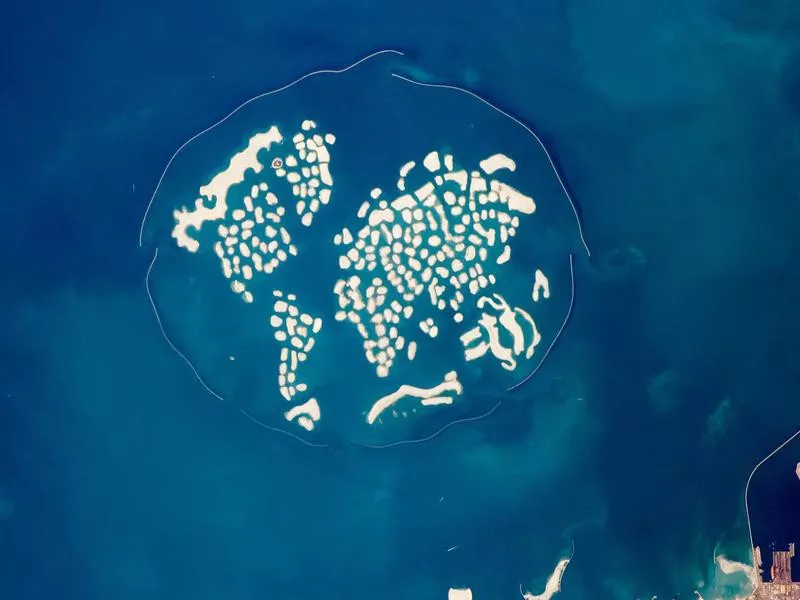
Member of the Expedition 22 crew / Wikimedia Commons
Where: Dubai
Opened in: Never opened
Dubai is not known for its modesty, and when they were first proposed, the World Islands were to be no exception. Modeled after the palm-shaped, man-made islands on the country’s coast, this faux-archipelago was supposed to resemble a map of the world and include one island for every country.
Since the project used sand dredged from the Persian Gulf, erosion and weathering were bound to be nemeses. But it was the 2008 global financial crisis that ultimately sank the project five years after it started, even though all the islands had been sold to private investors by then.
As of 2016, only nine of the 300 islands had seen any development at all. But not all hope is lost; more recently, interest in the World Islands has increased, and there may be a future for these disappearing sandbars yet.
Ozark Medieval Fortress

Ozark Medieval Fortress during the beginning of its construction in April 2010 Beth Hall / AP Photo
Where: Lead Hill, Arkansas
Opened in: 2010
Closed in: 2012
It sounds cool in concept: Build an exact replica of a 13th-century French castle using only materials and tools available back then, and invite visitors to come watch as the project takes shape over two decades.
Unfortunately, the Ozark Medieval Fortress was unable to live up to its promise. Two years after it opened to the public, it was finished — in financial ruin and unable to continue.
The French retirees who conceived of the concept were inspired by a similar project in their home country that is quite popular with visitors. They hoped that some of the millions of annual visitors to nearby Branson, Missouri, would come see the castle, but due to lackluster marketing efforts, unfavorable market forces and an inability to generate buzz, that never happened.
As the “New York Times” reported in 2013, “Investors expected 150,000 paying tourists that first year. Just 12,000 showed up.”
Son of Beast Rollercoaster
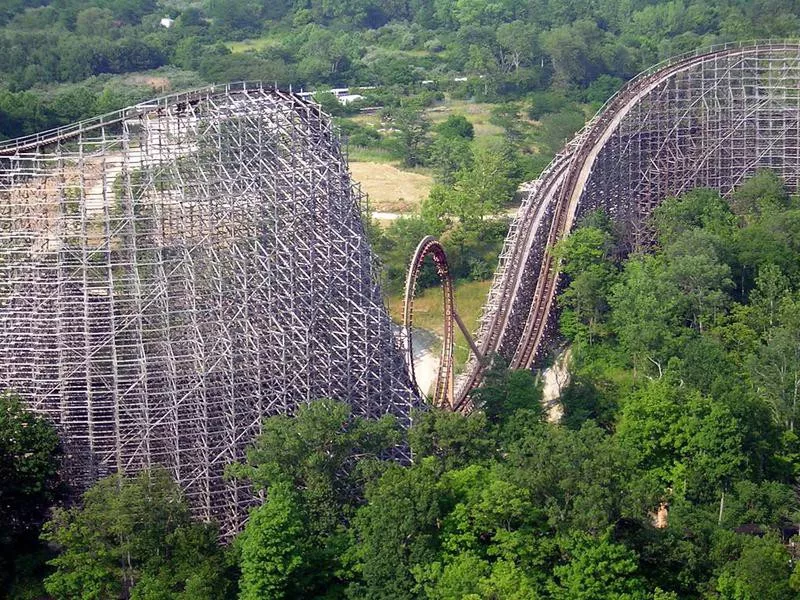
Chris Hagerman / Wikimedia Commons
Where: Mason, Ohio
Opened in: 2000
Closed in: 2009
Kings Island amusement park is best known for having the longest wooden roller coaster in the world. Opened in 1979, The Beast spans 7,359 feet and utilizes the surrounding terrain to wow riders during a four-minute journey. It was such a popular ride that it spawned Son of Beast, which for its brief life was the world’s tallest and fastest wooden coaster.
But unlike its father, Son of Beast was plagued by problems.
Despite the many thrills it provided, Son of Beast is best remembered for two major accidents that led to its permanent closure. The first involved an abrupt train stoppage that injured 27 riders in 2006; the second was an accident that resulted in a head injury to a woman in 2009.
In total, Kings Island sank $30 million into Son of Beast, only to see it torn down and replaced by a smaller coaster less than a decade after its debut.
Camelot Theme Park
Where: Charnock Richard, England
Opened in: 1993
Closed in: 2012
This theme park had a longer life than most on this list — nearly three decades — and admittedly a pretty cool concept. Modeled after King Arthur’s court, it featured the medieval-styled Merlin’s castle and jousting shows alongside more conventional coasters and kiddie rides.
But alas, poor weather and overshadowing events like the London Olympics and Queen’s Jubilee led to declining attendance and the park’s ultimate demise.
Today, it’s one of the eeriest and most photographed abandoned theme parks in the world, described at turns as “post-apocalyptic” and “like a horror movie set.”
Spreepark
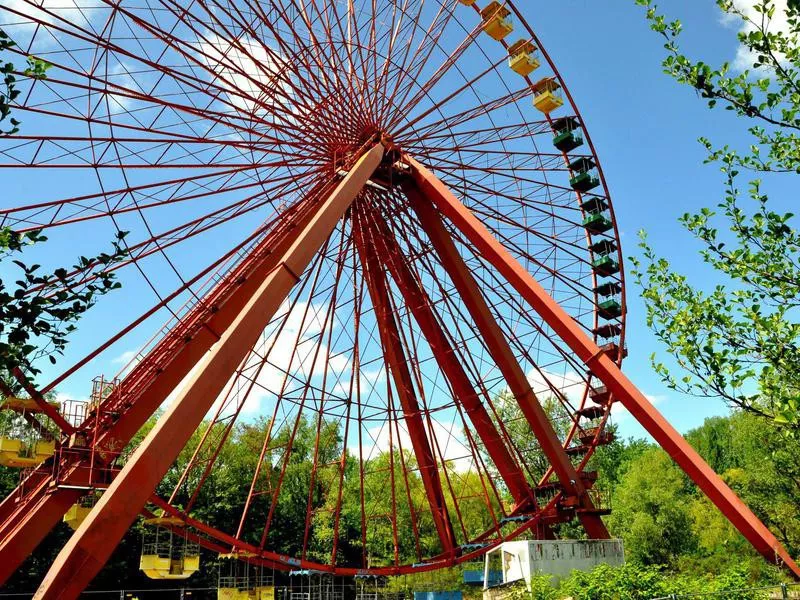
Jorge González / flickr
Where: Berlin, Germany
Opened in: 1969
Closed in: 2002
If there’s any attraction that can give Camelot Theme Park a run for its money in the category of “spooky abandoned amusement park,” it’s Spreepark. But what today is a vandalized, trash-riddled ghost attraction was once a rather successful destination.
When Spreepark opened eight years after the construction of the Berlin Wall in East Berlin, it initially flourished, welcoming nearly 2 million visitors annually to its Ferris wheel, coasters and popular carousel. After the fall of the Berlin Wall in 1989, the park was passed off to developers who tried to broaden its appeal to Western audiences. The efforts worked for a time, but attendance eventually dwindled, and in 2002 it closed for good.
Last year, WBUR summed up the park's unique relationship to its home city: “Over the last 50 years, Spreepark has mirrored the condition of Berlin: First, as a propaganda tool used in the communist East. Then as a renewed capitalist business, trying to find its footing. Finally, as a haven for partiers and graffiti artists.”
Ryugyong Hotel
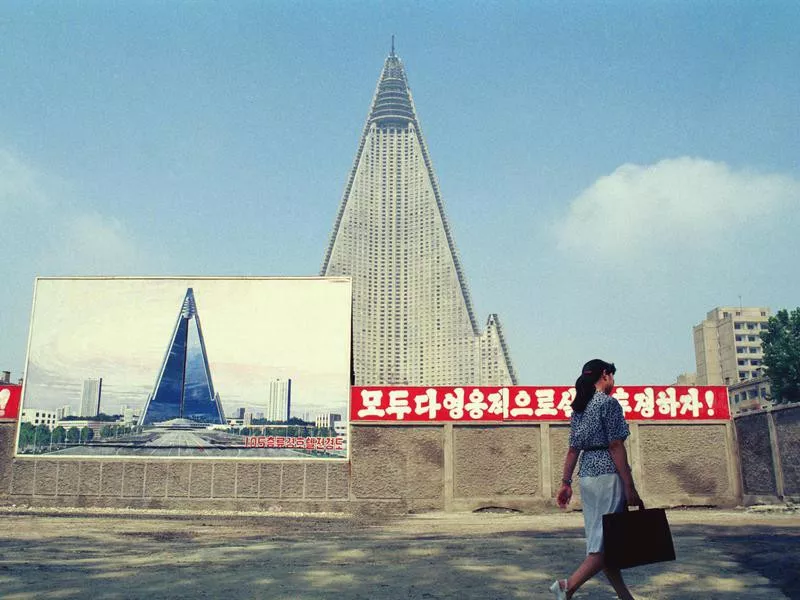
A woman walks past the site of the Ryugyong Hotel under construction in August 1990. Vincent Yu, File / AP Photo
Where: Pyongyang, North Korea
Opened in: Never opened
Shrouded in paranoia and secrecy, North Korea is largely unknown to outsiders. But one of its mysteries was long ago revealed: Ryugyong Hotel.
At 1,080-feet tall, this behemoth pyramid-shaped skyscraper is an imposing figure among the Pyongyang skyline. However, it’s little more than an unfinished hotel — and a symbol of North Korea’s failures as a communist state.
Construction began in 1987, but the fall of the Soviet Union and economic instability halted the project by 1992. The building had no windows or interior fittings, and it would stand that way until construction resumed in 2008 in the hopes of having it completed by the 100th birthday of the country’s first leader, Kim Il-sung, in 2012.
But while windows were eventually added, the building remains unfinished and unopened to this day. Appropriately, the structure has been bestowed with the nickname “Hotel of Doom.”
“Monkey Village”

Getty Images
Where: Sichuan, China
Opened in: 2003
Closed in: 2014 (sort of)
When residents of a small Chinese town sought to boost tourism revenue by making it a monkey village, their gambit initially paid off. They relocated more than 70 monkeys from the mountains to the town and, as expected, the tourists followed. So, too, did an investor willing to fund a permanent park for the monkeys.
After the investor’s death in 2014, though, the park shut down, and now 600 monkeys rule the village. Efforts to remove them have been partly successful, but the biggest issue seems to be the fact that many of the monkeys were born into captivity and simply don’t want to live in the wild now.
Camera-toting visitors still come to interact with the monkeys, but the villagers are paying the price.
Pripyat Amusement Park
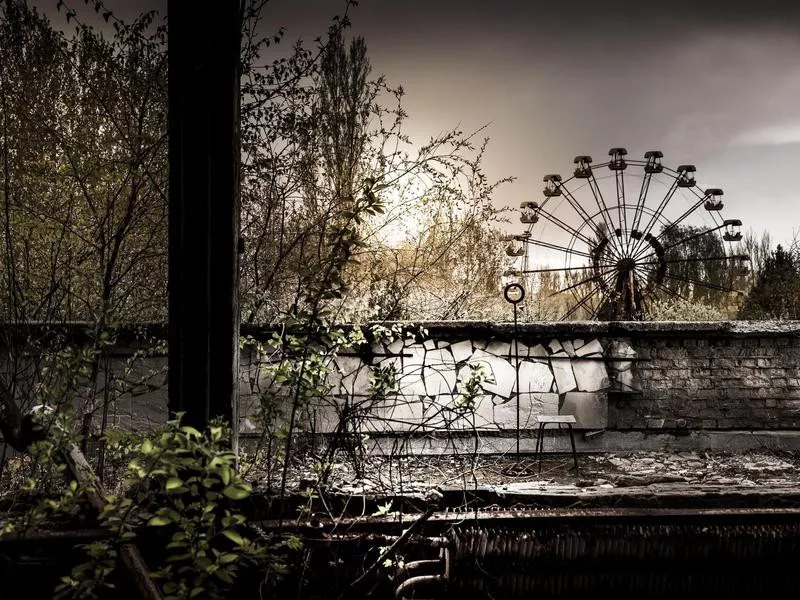
Getty Images
Where: Ukraine
Opened in: 1986
Closed in: 1986
It wasn’t poor planning or scandal that led to this park’s untimely demise, but tragedy.
Pripyat Amusement Park, with its Ferris wheel, bumper cars and other classic attractions, was set to open to the public in early May, 1986. But just weeks before its planned debut, a disaster at the nearby Chernobyl Nuclear Power Plant released 400 times more radioactive material than the atomic bombing of Hiroshima.
It’s been reported that the park was actually partially opened early on the day of the disaster, to keep locals distracted from what was going on. But once the full scope of the catastrophe became evident, the entire town of Pripyat was evacuated and the park was shuttered.
Due to the lingering impacts of radiation, the park — and indeed, the entire area — have remained abandoned ever since.
Rhode Island Tourism Video

YouTube
Ok, so this isn’t really an attraction, but it nonetheless merits mention as a high-profile tourism failure.
It’s hard to imagine a tourism video resulting in someone’s resignation, but that’s exactly what happened in Rhode Island in 2016. The state’s chief marketing officer took the proverbial bullet following the debut of a nearly two-minute video that showed, among other gaffes, a skateboarder outside a concert hall in Iceland instead of Rhode Island. (Close enough?)
At the time, it was part of the state’s effort to attract tourism under new Governor Gina Raimondo. But it was quickly panned, and many people said they simply didn’t understand the state’s new slogan of “Cooler & Warmer.” We’ll admit that it doesn’t really make sense under any circumstances.
In addition to the Iceland gaffe, the new website the state built for the campaign contained restaurants that were no longer in business and made the false claim that 20 percent of the entire country’s landmarks are located in Rhode Island.

